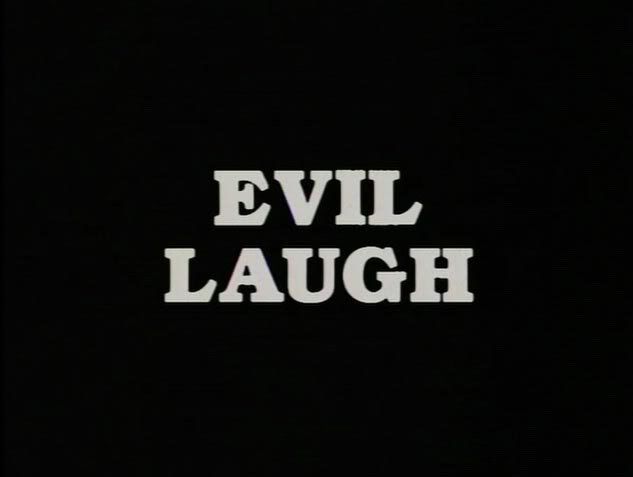Repost: Evil Laugh
Make no mistake about it—the Internet Movie Database is one of the most depressing websites you could ever possibly visit. I’m sure to most people it is simply a handy reference tool capable of ending a nagging bout of unresolved trivia within a few short minutes, but to my eyes it has always served as a catalogue of broken dreams and unmet promises—the single most powerful example of the heartbreak inherent in attempting to live a show business existence. Don’t believe me? Well, let’s take a quick look at the IMDb page dedicated to former 70s/80s teen idol Scott Baio. Like so many IMDb pages, it starts off promisingly with a TV movie directed by the man who would later bring George Lucas’ vision of primal teddy bears to life, continues on with a cult classic all-kids musical co-staring a young Jodie Foster, takes a bit of a detour with a rare Garry Marshall 1970s sitcom failure and some random guest spots, before jumping into the big time with the role that made him a star—Chachi on Happy Days. During that same period you also can find the awesomeness that is a certain “lost” 1979 roller disco classic, another cult classic starring a slightly less-young Jodie Foster and one of the more memorable “teen message” TV movies from that period.
Don’t believe me? Well, let’s take a quick look at the IMDb page dedicated to former 70s/80s teen idol Scott Baio. Like so many IMDb pages, it starts off promisingly with a TV movie directed by the man who would later bring George Lucas’ vision of primal teddy bears to life, continues on with a cult classic all-kids musical co-staring a young Jodie Foster, takes a bit of a detour with a rare Garry Marshall 1970s sitcom failure and some random guest spots, before jumping into the big time with the role that made him a star—Chachi on Happy Days. During that same period you also can find the awesomeness that is a certain “lost” 1979 roller disco classic, another cult classic starring a slightly less-young Jodie Foster and one of the more memorable “teen message” TV movies from that period.
Unfortunately it soon goes downhill from there, beginning with the wretched feature film that utterly failed to make him a movie star and the spin off that no one asked for. Then comes Charles in Charge, a truly terrible sitcom with an opening theme song that was a thousand times more memorable than any one of its episodes (with the possible exception of the one where he dated Samantha Fox). Around that same time he managed to appear in some movies you’ve never heard of and played a pig in Irwin Allen’s highly unfortunate star-studded two-part adaptation of Alice in Wonderland.
After two years of not appearing in front of a camera, he then returned to television as a co-star on a medically themed Murder She Wrote rip off, but when that joyride ended he managed only to snag the occasional sitcom guest spot and the kind of independent movie role that forced him to play characters named Zack Ramses and co-star with fellow sitcom has been Todd Bridges , while also occasionally directing episodes of the least-watched sitcoms in the history of the format. Finally, in 2004 we see his career reach its lowest point with a gig playing second banana to a crew of creepy digitally manipulated talking babies. But all was not without hope, since this was followed the next year by a four-episode arch on a critically acclaimed sitcom that was only too happy to stunt cast him as a successor to his former onscreen mentor.
That said, this brief victory was immediately undone by the two clearest signs that a celebrity’s career has reached its end—a depressingly self-deprecating cameo as himself in a major box office flop and a reality TV series based on exploiting his famous off screen behaviour.
In just one document we can watch the rise and decline of this man’s professional life—from successful kid actor to teen superstar to TV hack to pop culture punchline—and appreciate the cruelty that fate can play with those who merely want to entertain us. But this alone does not prove my contention that the IMDb is one of the most depressing websites known to man. No, what truly makes my thesis incontrovertible is the fact that Baio’s page actually serves as the documentation of a Hollywood success story.
By the standards of his business, Scott Baio had an amazing ride, the likes of which 99% of his professional peers will never experience themselves. Every day people demean and debase themselves in the hope that someday, with the right kind of luck, they might be blessed with a career that sucked ten times as much as Baio’s did. For proof of this you only have to look at the IMDb page of Steven Baio, Scott’s brother of indeterminate age.
Now this is what I’m talking about when I refer to the inherent pathos of the Internet Movie Database—a page filled only with a handful of sparsely divided nepotistically-achieved acting, writing and producing credits and the lone accomplishment of a truly terrible 1988 slasher movie that managed to be made during that brief period in the 80s when the demands of the home video market made it possible for anything ever recorded on film to make it to the hands of unwary viewers.
I am, of course, talking about:
The genesis of this frequently excruciating exercise in incompentent filmmaking came about when Steven Baio, fresh from a couple of guest spots on Happy Days and Joanie Loves Chachi, met Dominick Brascia, who had just set the world aflame with his vivid portrait of a fat, chocolate-eating retard in Friday the 13th Part V: A New Beginning , in an acting class.
Acting classes serve several very important purposes in Los Angeles. The first is that they keep out of work actors employed through the exploitation of actors even more out of work than they are. The second is that they allow folks who can't even get an audition, much less a role, the illusion of professional progress. And the third is that they enable potential soulmates like Baio and Brascia to get together and collaborate on screenplays designed to elevate them to the heights of show business stardom.
This is why acting classes are evil and should be outlawed for the sake of our common humanity.


Having bonded over their mutual homesickness for New York, Baio and Brascia first dreamed of making a comedy in the same vein of the classic Abbott & Costello films of the 40s, which they creatively dubbed Two Guys From Brooklyn. Unfortunately despite the collective resources that came from being Chachi's homely brother and the guy who played Young Man Buying Ice Cream in the film that completely failed to make Jim Carrey a movie star, the two young filmmakers were only able to raise an infinitesimal fraction of the money they needed to make their dream project a reality.
Undaunted, the two of them decided to take the money they had managed to raise from other wannabe actors and their parents and use it to make the same kind of movie that had provided Brascia with his largest role to date. Both of them worked on the screenplay (although the IMDb incorrectly credits the work solely to Baio) and though Brascia had written a key role with himself in mind, he elected to not appear in front of the camera when it was decided that he would direct the project.
Blessed with a generous seven day shooting schedule and a cast filled with other acting class "actors", they worked their asses off and got the script on film. The result was truly terrible, but it made it to video and would forever remain the crowning achievement of their Hollywood experience.
That they were able to do this, when so many other of their fellow acting students didn't, makes Evil Laugh another counter-intuitive success story. Just not an artistic one.

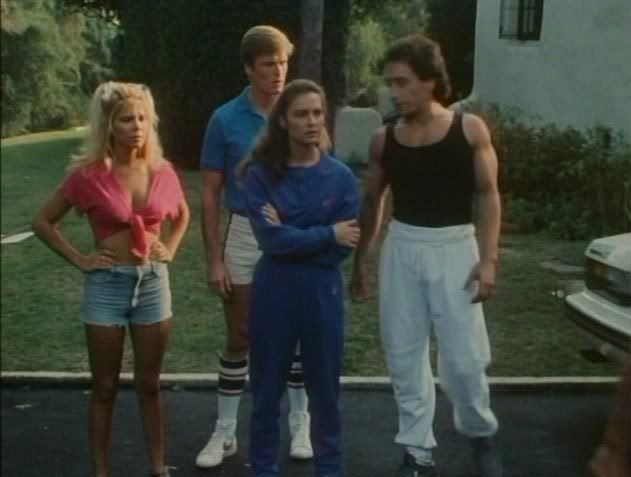
But the truth is that it is not the misguided hopes or creative incompetence of Baio and Brascia that makes the watching of Evil Laugh such an unusually melancholic experience. No, the fault for that lies directly in the lap of the actress who portrays Connie, the film's requisite Final Girl.
In 1988 Kim McKamy was a 29 year-old transplant from North Carolina trying to make it as an actress in Los Angeles. Since arriving in Hollywood she had managed to book some supporting roles in a handful of extremely low budget direct-to-video horror movies and a small bit part in the third film of a franchise based around the adventures of a young former streetwalker. Evil Laugh would be her fifth film and her largest role to date.
Like all serious actresses who dream of future stardom, McKamy had been careful to avoid roles that called for nudity and when Baio and Brascia asked her to get naked in a shower scene at the end of their film, she balked and insisted that they hire a body double. The woman they hired proved, predictably, to be considerably better endowed than she was, which meant she had to wrap a towel around her shoulders during the scenes she appeared in a chaste swimsuit, lest her true dimensions give the upcoming deception away.
Given a script that allowed her to show off all of her emotive skills, McKamy gave it everything she had in Evil Laugh, but rather than vindicate her years of struggle the results only served to prove that for all of her enthusiasm and desire, she simply wasn't a good actress. Nearing thirty and with the kinds of parts she had played drying up as the slasher cycle came to its inevitable end, she found herself unemployed and at what most would conclude was the end of her dream.
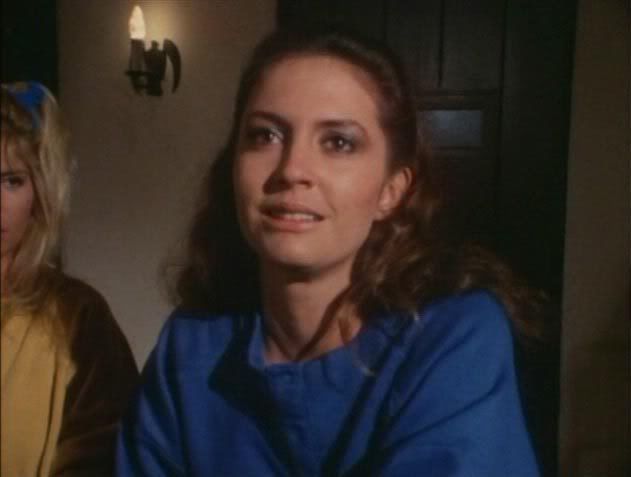
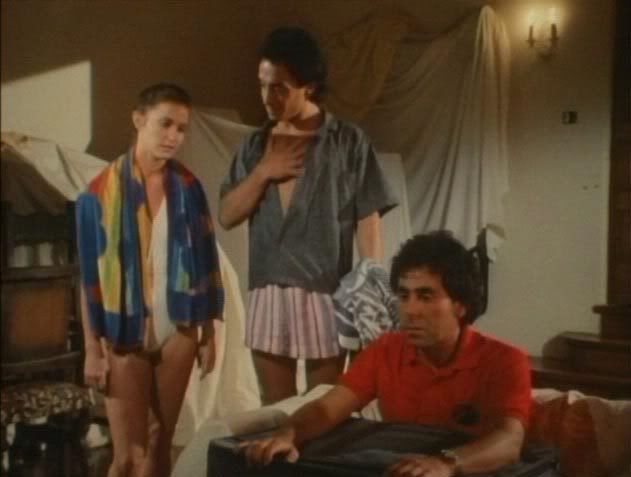
But then any student of Hollywood can tell you that it is a business in which ambition is frequently much more important than ability. Despite her obvious limits as an actress Kim McKamy still very much wanted to perform and be a star, so when the mainstream industry turned its back on her, she decided to go somewhere else where her efforts would be much more greatly appreciated.
Two years after she appeared in Evil Laugh, McKamy's face and body started appearing on the shelves of a completely different section of the video store than where her previous films were usually found. With the change in location also came a change in name. Billed as Ashlyn Gere, she had made the leap to a genre of film where merely showing her breasts was the least of her concerns. Now gifted with a pair of custom-made mammaries that must have made her former body double weep with envy, she would never have to wear a towel around her shoulders ever again.
The difference couldn't have been more dramatic. While Kim McKamy struggled to reach even the lowest rungs of the show business ladder, Ashlyn Gere instantly climbed to the top of its less reputable alternative, where she found not only the fame she desired, but also an unheard of degree of respect and recognition. In "real" movies her performances seemed overly mannered and contrived, but in the world of adult cinema they were considered award worthy. In 1993 and 1995 she won a total of four acting awards at the pornographic equivalent of the Oscars, and that first year was named the first ever "Female Performer of the Year".
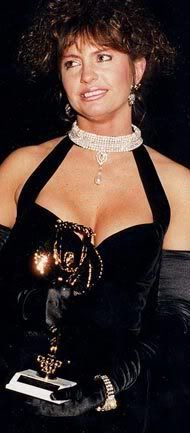
In the years that followed she became the extremely rare adult film actress who was allowed the opportunity to appear in guest roles on network television, thanks to the efforts of the writing/producing team of Glen Morgan and James Wong. With their help she enjoyed featured parts on the The X-Files, Millennium and Space: Above and Beyond, as well as roles in their films The One and Willard
And, in a fitting irony, the actress who had insisted on having a body double in Baio and Bruscia's little slasher movie, herself became a body double for Sharon Stone and Demi Moore in Basic Instinct and Indecent Proposal--the two most successful projects she would ever be associated with in a career that finally ended in 2003, when she left Ashlyn Gere behind and moved to Texas to become a real estate agent.
Having found a way to achieve the fame and recognition she always wanted, Kim McKamy's IMDb page also represents another Hollywood success story, which--along with the other examples I've provided in this post--begs the question: If Hollywood successes are this pathetic and depressing, then what the holy fuck are actual failures like?


I suppose that before I end with the usual Slasher Movie Statistics, I might as well spend at least a paragraph discussing the actual film. It sucks pretty damn hard. It's not quite as unbearable as Girls Nite Out, but it's close. Badly shot, directed, written and acted, the film's only real distinction is the inclusion of a character named Barney who manages to survive the initial ordeal entirely through the exploitation of his knowledge of horror movies--a satiric nod to the cliches of the genre that predated Scream by eight years. That said, the actor who plays the character is extremely irritating and the poor execution of the conceit completely undoes its initial cleverness. In the end the film definitely serves as a much better example of the terrible realities of life on the low end of the Hollywood food chain than it does as an entertaining slasher movie.
Slasher Movie Statistics Body Count: 11 (8 men/3 women
Shower Scenes:1
Instances of Nakedity: 2 (3 if you're willing to count man ass, which you are entirely free to do)
Instances of Blatant Homoeroticism Played For Laughs of: 2
Instruments of Death: Machete, electric drill, ax, bare hands, microwave, hand gun and scissors
Instances of Unintentional Cannibalism: 1
References to Pot: 0
Amount of Time Required to Correctly Identify Killer: At a certain point midway through the film there is only one character left who could have conceivably been around to commit all of the murders we have seen thus far. They are the person behind the mask.
Truly Terrible Pop Songs Repeated Throughout The Film Ad Naseam: 2
Cheesy References to Other Horror Movies: Too many to keep track of thanks to the Fangoria reading Barney.
Utterly Pointless Trivia #1: While Kim McKamy turned to porn after Evil Laugh, her blond co-star Jody Gibson went even a step higher (or lower, depending on your point of view) when she filled in the void created by the arrest of Heidi Fleiss to become Los Angeles' number one madam.
Utterly Pointless Trivia #2: Tony Griffin, the actor who spends a great deal of the movie's run time wearing a studded bondage collar, is the son of the recently deceased talk show host, game show impresario and famed crooner of "I've Got A Lovely Bunch of Coconuts", Merv Griffin.
Final Girl Rating: 1 (out of 10)
